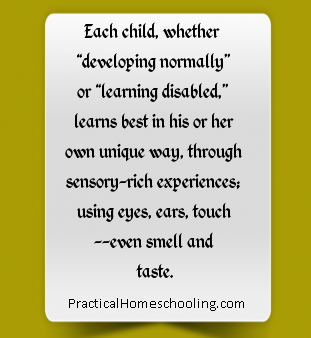Types of Tykes: Enjoying Your Little Learner’s Style
By Melissa Morgan
Printed in Practical Homeschooling #92, 2010.
 How teaching to your tyke’s learning style can make homeschooling more rewarding
How teaching to your tyke’s learning style can make homeschooling more rewarding

| 
|
Our youngest child, Susie, spent her first months in the hospital. She
started out not breathing, virtually blind, and was given several
diagnoses of rare syndromes. She’s now a spunky, petite homeschooler,
reading and writing and doing math at home, but we still live moment by
moment with a life-threatening condition requiring daily medication. Can
I pick up a standard school text and teach her? Not likely. I seek out
audio materials, and she uses a video magnifier to make reading less
tiring on her eyes. Her physical challenges influenced her learning
type.
 However, each child, whether “developing normally” or “learning
disabled,” learns best in his or her own unique way, through
sensory-rich experiences—using eyes, ears, touch, even smell and taste.
Some people show a marked preference for learning through one sense, as
opposed to another.
However, each child, whether “developing normally” or “learning
disabled,” learns best in his or her own unique way, through
sensory-rich experiences—using eyes, ears, touch, even smell and taste.
Some people show a marked preference for learning through one sense, as
opposed to another.
Lookers and Listeners
Even at an early age, Visual Violet enjoyed looking at pictures. Like
many visual learners, she often has her nose in a book and easily
remembers abstract letter combinations.
Visual learners find it simple to see pictures in their memories. They
may be early readers and may learn well with workbooks. They remember
how to spell words after seeing them.
Most children enjoy listening and talking about information. Some strong
auditory learners, like Auditory Augie, find it difficult to understand
what they learn through their eyes. However, when they hear material
aloud, they understand, and remember. Auditory learners also enjoy
learning through rhymes and songs. Hearers love to learn by listening to
stories.
Kids who prefer to learn through auditory methods may find that it helps
to listen to background music while learning. Classical music,
especially Mozart, may prove helpful. Although controversial, some
studies claim to show a “Mozart Effect” of increasing I.Q. through
classical music. Either way, if it seems to help your child learn,
what’s the harm?
Some youngsters, such as Combo Clyde, like to learn by a combination of
visual and auditory methods. If so, get to know your children’s
librarian, and check out learning videos. Find free lyrics and music for
learning songs at Kididdles, kididdles.com/lyrics/learning.html. Try out
free learning demos, such as audio books for mp3 players, from Weekly
Reader, at ufillitup.com.
Shakers and Movers
As a toddler, Grabby Gabbie tried to touch and eat everything. If your
tyke is the touchy/feely/eater variety, you are blessed with a handful!
That doesn’t mean that your challenging youngster is bad and the quiet,
timid kid is good. It may mean you need extra mommy time to recover from
the stress, however!
Does your wiggle-worm tyke learn best by doing, using his or her hands
and whole body to learn? At school, active kids—doers—usually get in
trouble for moving all the time. They might hate visual learning. It
might even make them feel sick. Auditory learning might seem impossible.
Doers sometimes feel like they don’t fit in at school, church, or in
other groups. Sometimes they get labels, like ADHD or LD or dyslexia. If
so, there are ways that you can work with your child’s natural learning
style, whatever your child’s age.
According to Dyslexia Online Magazine (dyslexia-teacher.com), “Studies
from the National Institutes of Child Health and Human Development have
shown that for children with difficulties learning to read, a
multi-sensory teaching method is the most effective teaching method. . .
. A dyslexic child may experience difficulties with either or both of
these senses. The child’s vision may be affected by difficulties with
tracking, visual processing, or seeing the words become fuzzy or move
around. The child’s hearing may be satisfactory on a hearing test, but
auditory memory or auditory processing may be weak. . . . The answer is
to use your senses, especially touch and movement (kinetic). This will
give your brain tactile and kinetic memories to hang on to, as well as
the visual and auditory ones.”
Kids who need to move can mix music and physical activity with learning.
Try skip counting by twos, fives and tens as you jump rope.
Doers can also be hearers. Are you are a hearer and a doer that can’t
seem to sit still? You may like to exercise, walk around, or jump rope
while saying or singing a lesson.
Where to Start?
“Learning is active, not passive. Learning is doing, making, building,
arranging, figuring out, changing”—Owl and Mouse Software,
yourchildlearns.com.
At preschool age, a child’s learning style may not be apparent yet;
handedness might not yet be set either. Even so, learning through all
the senses will probably work best. Offer many choices for learning by
looking, hearing, and hands-on playing. When giving a fork or a crayon,
put it in the middle—no need to give your tyke the idea that there is
only one correct hand to use.
“Anything we find confusing or complicated is best learned when we can
see, hear, and do something in order to understand it. In general,
however, by age 8 or 9, a child is stronger in one of those three areas:
seeing (the visual learner), hearing (the auditory learner) or doing
(the kinesthetic, or hands-on learner).”—What Do I Need to Know About
Learning Styles? Kathryn Stout (author of The Natural Speller),
designastudy.com/teaching.
Magnetic letters and Scrabble tiles give hands-on learners a good grasp
of early language skills. Math seldom makes sense for youngsters unless
you use some type of manipulative: counting beans, spending money,
dividing pizza, whatever. It is one thing to memorize facts; quite
another to understand them! Manipulatives turn abstract ideas into real
life. Many students love manipulatives like Wrap-Ups, plastic counting
bears, Cuisenaire building rods, dominos, or building bricks. See, hear,
do, and understand it! As always, of course, closely supervise small
objects for young children who may be putting things in their mouths.
A Guide at the Side
Manual guidance—gently guiding the hands and feet—can help lookers learn
with their sense of touch. Young children learn well with manual
guidance. Have you tried guiding your two-year-old’s hands to play
“Patty Cake” or to show “How many?”
Manual guidance works just as well for older people. An instructor may
guide a learner’s arm to teach the proper stroke for golf. A ballet
teacher may place a student’s foot into the proper ballet position.
Try manual guidance for yourself. Ask if you can help. Gently guide a
beginner’s hand to hold a pencil. Help write the letter. Use verbal cues
as well. Link the new information with what the person already knows.
Gradually, help less and less.
Next time, if your child forgets how to write the letter, just speak a
verbal cue as a hint. This helps if the child is also an auditory
learner. For instance, “Did you forget letter Q? It looks like letter O,
with a tail.” Or “Remember how to write letter H? It looks like a fat
letter I, tipped over on the side.” Or, “Letter H looks like a little
ladder.” Or, “Letter H looks like two sticks, joined at the middle with
another stick.”
Taste and See
It’s funny how you seldom hear much about smell and taste, the neglected
senses for learning. Long ago, children licked honey off the page before
they read from the Bible. I’ll bet that helped them remember! The Bible
says “Taste and see that the Lord is good.”
You may not want to get your books sticky, but making “letter cookies”
uses all your senses—even taste—to learn. Explore your sense of touch to
form the letters. Hear the squishing of the dough in your hands. Say and
hear the sounds that each letter makes. Look and see the letters, as you
decorate them with icing or sprinkles. Smell yummy letters cooking.
Taste the letters when they are done. Put letters together and say the
letter combination sounds. Taste and see—good!
What type is your tyke? The outside appearance doesn’t matter, but
understanding how your child thinks and acts makes a difference in
learning, for a lifetime.
Melissa L. Morgan is the co-author of Educational Travel on a Shoestring
and Homeschooling on a Shoestring. With her husband, Hugh, she has
homeschooled their three children from birth, taking advantage of many
educational opportunities in the real world. She invites you to visit
her website at www.eaglesnesthome.com.